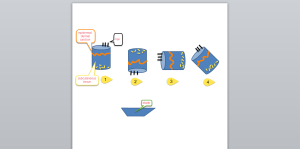In the previous Blog “Dermatopathology 101”, a clear outline of material was provided which ensured the skin’s histology presentation as an organ in the final microscope slide. We discussed basic skin histology, and important aspects of embedding and microtomy.
In this Blog “Dermatopathology 102”, we will continue the discussion of the handling of skin specimens for dermatopathology to ensure the preparation of optimum microscope slides.
Tissue Processing
As mentioned previously, skin specimens are actually composed of three tissue types: epidermis, dermis and adipose. Additionally, most skin specimens are small. Given these factors, it is important to avoid over-processing skin specimens. Over-processing may lead to tissues being hard and “scratchy” during microtomy. The schedule detailed below for Routine Processing is optimal for all skin biopsies and excisions, as long as the pieces are no more than 3 mm thick. Additionally, a Rapid Processing schedule is provided for skin specimens / biopsies and/or small tissues measuring less than 3 mm. This schedule is ideal for “rush” biopsy specimens.
Routine Tissue Processing Schedule for Skin Specimens
STATION # |
REAGENT |
TIME (min) |
TEMP |
| 1 | 10% formaldehyde | 30 | ambient |
| 2 | 50% alcohol | 30 | “ |
| 3 | 80% alcohol | 30 | “ |
| 4 | 95% alcohol | 30 | “ |
| 5 | 95% alcohol | 30 | “ |
| 6 | 100% alcohol | 42 | “ |
| 7 | 100% alcohol | 42 | “ |
| 8 | 100% alcohol | 42 | “ |
| 9 | xylene | 45 | “ |
| 10 | xylene | 45 | “ |
| 11 | paraffin | 30 | 60 C |
| 12 | paraffin | 30 | 60 C |
| 13 | paraffin | 30 | 60 C |
Notes
- The above schedule is for a closed system, pressure vacuum tissue processor.
- Most skin specimens are small and submitted in formaldehyde. This procedure assumes the specimens are already fixed.
- All stations use pressure / vacuum.
- Paraffin stations only are heated.
Rapid Tissue Processing Schedule for Skin Specimens
STATION # |
REAGENT |
TIME (min) |
TEMP |
| 1 | 10% formaldehyde | 5 | ambient |
| 2 | 50% alcohol | 5 | “ |
| 3 | 80% alcohol | 5 | “ |
| 4 | 95% alcohol | 5 | “ |
| 5 | 95% alcohol | 10 | “ |
| 6 | 100% alcohol | 15 | “ |
| 7 | 100% alcohol | 15 | “ |
| 8 | 100% alcohol | 20 | “ |
| 9 | xylene | 20 | “ |
| 10 | xylene | 20 | “ |
| 11 | paraffin | 20 | 60 C |
| 12 | paraffin | 20 | 60 C |
| 13 | paraffin | 20 | 60 C |
Notes
- The above schedule is for a closed system, pressure vacuum tissue processor.
- Suitable skin specimens are small biopsies submitted in formaldehyde. This procedure assumes the specimens are already completely fixed and measure no greater than 3 cm in the greatest dimension with the remaining dimensions smaller.
- This procedure is not suitable for excisional specimens.
- All stations use pressure / vacuum.
- Paraffin stations only are heated.
- Microwave assisted processing of small biopsies may also be successful. The use of microwaves, combined with the omission of xylene, results in processing times of one to two hours.
- Specimens for demonstration of urate crystals (i.e. suspected gout) should be fixed in Carnoy’s fixative, or 100% alcohol, and processed from that point to prevent exposure to any water which may dissolve the crystals.
The principles of proper embedding for microtomy
There can be four main options of approaching the skin block by the microtomy blade, or four variants of skin specimens’ microtomy, as shown in Figure 1.



